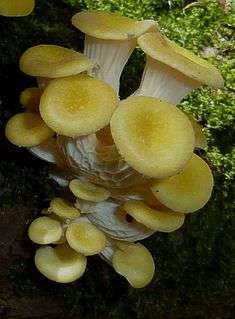Pleurotus citrinopileatus
Pleurotus citrinopileatus, the golden oyster mushroom (tamogitake in Japanese), is an edible gilled fungus. Native to eastern Russia, northern China, and Japan, the golden oyster mushroom is very closely related to P. cornucopiae of Europe, with some authors considering them to be at the rank of subspecies.[2] In far eastern Russia, P. citrinopileatus, they are called iI'mak, is one of the most popular wild edible mushrooms.[3]
| Pleurotus citrinopileatus | |
|---|---|
 | |
| Scientific classification | |
| Kingdom: | |
| Division: | |
| Class: | |
| Order: | |
| Family: | |
| Genus: | |
| Species: | P. citrinopileatus |
| Binomial name | |
| Pleurotus citrinopileatus | |
| Synonyms | |
| |
| Pleurotus citrinopileatus | |
|---|---|
float | |
| gills on hymenium | |
| cap is flat or depressed | |
| hymenium is decurrent | |
| stipe is bare | |
| spore print is pink | |
| ecology is saprotrophic | |
| edibility: choice | |
Description
The fruiting bodies of P. citrinopileatus grow in clusters of bright yellow to golden brown caps with a velvety, dry surface texture. Caps range from 20–65 millimetres (3⁄4–2 1⁄2 inches) in diameter. The flesh is thin and white, with a mild taste and without a strong smell. Stems are cylindrical, white in color, often curved or bent, and about 20–50 mm (3⁄4–2 in) long and 2–8 mm (1⁄16–5⁄16 in) in diameter. The gills are white, closely spaced, and run down the stem. The spores of the golden oyster mushroom are cylindrical or elliptical in shape, smooth, hyaline, amyloid, and measure 6-9 by 2–3.5 micrometres.[2][3]
Ecology
The golden oyster mushroom, like other species of oyster mushroom, is a wood-decay fungus. In the wild, P. citrinopileatus most commonly decays hardwoods such as elm.[2][3] Spores are spread by Callipogon relictus, a beetle.
Uses
Golden oyster mushrooms are cultivated commercially, usually on a medium of grain, straw, or sawdust.[4] Pleurotus species are some of the most commonly cultivated mushrooms, particularly in China, due to their ease of cultivation and their ability to convert 100 g of organic refuse into 50-70 g of fresh mushrooms.[5]
P. citrinopileatus mushrooms are a source of antioxidants.[6] Extracts from P. citrinopileatus have been studied for their antihyperglycemic properties, decreasing blood sugar levels in diabetic rats.[7] They have also been studied as a source of lipid-lowering drugs;[8] P. ostreatus, a related oyster mushroom, has been found to contain the cholesterol-lowering drug lovastatin.[9]
See also
References
- Singer, R. (1943). "Das System der Agaricales. III". Annals of Mycology. 41: 1–189.
- Ohira, Ikuo (1990). "A revision of the taxonomic status of Pleurotus citrinopileatus" (PDF). Reports of the Tottori Mycological Institute. 28: 143–150. Archived from the original (PDF) on 2011-07-22.
- Parmasto, Erast (July 1987). "Pleurotus citrinopileatus, one of the favourites". Mycologist. 1 (3): 106–107. doi:10.1016/S0269-915X(87)80076-9.
- Stamets, Paul (2000). Growing gourmet and medicinal mushrooms. Ten Speed Press. pp. 274–289. ISBN 1-58008-175-4.
- Chang, Shu-ting; Miles, Philip G. (2004). "Pleurotus — A Mushroom of Broad Adaptability". Mushrooms: cultivation, nutritional value, medicinal effect, and environmental impact (2nd ed.). CRC Press. pp. 315–325. ISBN 978-0-8493-1043-0.
- Yu-Ling Lee; Gi-Wei Huang; Zeng-Chin Liang & Jeng-Leun Mau (June 2007). "Antioxidant properties of three extracts from Pleurotus citrinopileatus". LWT - Food Science and Technology. 40 (5): 823–833. doi:10.1016/j.lwt.2006.04.002.
- Shu-Hui Hu; Jinn-Chyi Wang; Juang-Lin Lien; Ean-Tun Liaw & Min-Yen Lee (March 2006). "Antihyperglycemic effect of polysaccharide from fermented broth of Pleurotus citrinopileatus". Applied Microbiology and Biotechnology. 70 (1): 107–113. doi:10.1007/s00253-005-0043-5. PMID 16001252.
- Shu Hui Hu; Zeng Chin Liang; Yi Chen Chia; Juang Lin Lien; Ker Shaw Chen; Min Yen Lee & Jinn Chyi Wang (2006). "Antihyperlipidemic and Antioxidant Effects of Extracts from Pleurotus citrinopileatus". Journal of Agricultural and Food Chemistry. 54 (6): 2103–2110. doi:10.1021/jf052890d. PMID 16536582.
- Gunde-Cimerman N, Cimerman A (March 1995). "Pleurotus fruiting bodies contain the inhibitor of 3-hydroxy-3-methylglutaryl-coenzyme A reductase-lovastatin". Exp. Mycol. 19 (1): 1–6. doi:10.1006/emyc.1995.1001. PMID 7614366.
External links
| Wikimedia Commons has media related to Pleurotus citrinopileatus. |